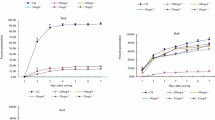Abstract
Previous results obtained in soybean–wheat rotations under no-tillage conditions showed reductions in the seedbank of the weed species Commelina benghalensis, but no alteration in the seedbank of Acanthospermum hispidum in areas infested with Brachiaria plantaginea. Analyses of the soluble fraction of B. plantaginea indicated the predominance of aconitic acid (AA) among the aliphatic acids and ferulic acid (FA) among the phenolic acids. Laboratory bioassays using C. benghalensis and A. hispidum were carried out to evaluate phytotoxic effects of pure organic acid solutions and dilute extracts of B. plantaginea on seed germination, root development, and fungal germination. Solutions of AA and FA were prepared at 0.25, 0.50, and 1.0 mM. Extracts of B. plantaginea were diluted to obtain concentrations of AA similar to those in the prepared solutions. Seeds were sown on 0.5% agar (containing AA, FA, or diluted extract) in plastic-covered receptacles and maintained in a germination chamber for 10 days. AA and FA solutions and the B. plantaginea extract reduced germination and root length, mainly of C. benghalensis. AA also stimulated the development of endophytic fungi (Fusarium solani), which had complementary adverse effects on C. benghalensis germination. FA and AA may play important roles in reducing the seedbank of some weed species, acting directly on germination and development and, indirectly, by stimulating endophytic fungi that alter germination.
Similar content being viewed by others
REFERENCES
Azevedo, J. L. 1998. Endophytic microorganisms, inI. S. Melo and J. L. Azevedo (eds.). Ecologia Microbiana. EMBRAPA-CNPMA, Jaguariúna, São Paulo, 117–137.
Burke, D. G., Watkins, K., and Scott, B. J. 1990. Manganese toxicity effects on visible symptoms, yield, manganese levels, and organic acid levels in tolerant and sensitive wheat cultivars. Crop Sci. 30:275–280.
Cochran, V. L., Elliot, L. F., and Papendick, R. I. 1977. The production of phytotoxins from surface crop residues. Soil Sci. Soc. Am. J. 41:903–908.
Favero, C., Jucksch, I., Alvarenga, R. C., and Costa, L. M. 2001. Modificações na população de plantas espontâneas. Pesq. Agropec. Bras. 36:1355–1362.
Franchini, J. C., Hoffmann-Campo, C. B., Torres, E., Miyazawa, M., and Pavan, M. A. 2003. Organic composition of green manures during growth and its effect on cation mobilization in an acid oxisol. Commun. Soil Sci. Plant Anal. 34:2045–2058.
Friebe, A., Schulz, M., Kuck, P., and Schnabl, H. 1995. Phytotoxins from shoot extracts and root exudates of Agropyron repensseedlings. Phytochemistry 38:1157–1159.
Goodwin, T. W. and Mercer, E. I. 1983. Introduction to Plant Biochemistry. Pergamon Press, New York.
Guenzi, W. D. and McCalla, T. M. 1966. Phenolic acids in oat, wheat, sorghum and corn residues and their phytotoxicity. Agron. J. 58:303–304.
Hanine, H., Mourgues, J., and Molinier, J. 1990. Aconitic acid removal during cane juice clarification. Intern. Sugar J. 92:219–238.
Hatzios, K. K. 1987. Biotechnology applications in weed management now and in the future. Adv. Agron. 39:325–375.
Jones, D. L. 1998. Organic acids in the rizosphere-a critical review. Plant Soil 205:25–44.
Katsuhara, M., Sakano, K., Sato, M., Kawakita, H., and Kawabe, S. 1993. Distribution and production of trans-aconitic acid in barnyard grass (Echinochloa crus-gallivar. oryzicola) as putative antifeedant against brown planthoppers. Plant Cell Physiol. 34:251–254.
Liebl, R. A. and Worsham, A. D. 1983. Inhibition of pitted morning glory (Ipomoea lacunosaL.) and certain other weed species by phytotoxic components of wheat (Triticum aestivumL.) straw. J. Chem. Ecol. 9:1027–1043.
Redlin, S. C. and Carris, L. M. 1996. Endophytic Fungi in Grasses and Woody Plants: Systematics, Ecology, and Evolution. USDA/ARS, Systematic Botany and Mycology Laboratory, Beltsville, MD.
Rice, E. L. 1984. Allelopathy. Academic Press, New York.
Sas Institute. 1996. Proprietary of Software Release. SAS Institute, Cary, NC.
Severino, F. J. and Christoffoleti, P. J. 2001. Banco de sementes de plantas daninhas em solo cultivado com adubos verdes. Bragantia 60:201–204.
Souza-Filho, A. P. S., Rodrigues, L. R. A., and Rodrigues, T. J. D. 1997. Efeitos do potencial alelopático de três leguminosas forrageiras sobre três invasoras de pastagens. Pesq. Agropec. Bras. 32:165–170.
Thompson, F., Schaefer, S. C., and Madison, J. T. 1997.Role of aconitate isomerase in transaconitate accumulation in plants. J. Agric. Food Chem. 45:3684–3688.
Voll, E., Karan, D., and Gazziero, D. L. P. 1997a. Population dynamics of Commelina benghalensisL. under soil and herbicide management. Pesq. Agropec. Bras. 32:571–578.
Voll, E., Karan, D., and Gazziero, D. L. P. 1997b. Population dynamics of Acanthospermum hispidumDC. under soil and herbicide management. Pesq. Agropec. Bras. 32:897–904.
Watanabe, K., Katsuhara, M., Nakao, H., and Sato, M. 1997. Detection and molecular analysis of plant-and insect-associated bacteria harboring aconitate isomerase involved in biosynthesis of trans-aconitic acid as antifeedant in brown planthoppers. Curr. Microbiol. 35:97–102.
Author information
Authors and Affiliations
Corresponding author
Rights and permissions
About this article
Cite this article
Voll, E., Franchini, J.C., Da Cruz, R.T. et al. Chemical Interactions of Brachiaria plantaginea with Commelina bengalensis and Acanthospermum hispidum in Soybean Cropping Systems. J Chem Ecol 30, 1467–1475 (2004). https://doi.org/10.1023/B:JOEC.0000037752.57907.fb
Issue Date:
DOI: https://doi.org/10.1023/B:JOEC.0000037752.57907.fb




